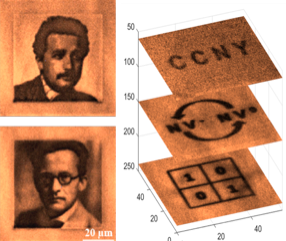Defects in diamond: A unique platform for optical data storage in 3-D

In the world of big data, there are limitations on how to store large volumes of information. Typical home-computer hard disk drives consume a lot of power and are limited to a few terabytes per drive. Optical storage media like DVD and Blu-ray are energy efficient and cheap, but storage densities are very low due to the planar nature of the discs and the ever-daunting optical diffraction limit. However, researchers have made inroads into developing a 3-D diamond chip that could store vastly more data than current technologies.
In a new study appearing in the journal Science Advances, physicists in the group of Prof. Carlos Meriles at City College of the City University of New York (CUNY) seek to circumvent data storage limits by exploiting the charge state and spin properties of the Nitrogen-Vacancy (NV) center in diamond. The researchers have devised a memory bit that is no longer a diffraction-limited bump on the surface of a DVD, but instead an atomic-sized defect that can trap and release electrons at will with laser excitation. As proof of principle, the Meriles Group used optical microscopy to read, write and reset information in a diamond crystal with a two-dimensional bit density comparable to present DVD technology. Here, the crystal is equivalent to a rewritable memory storage device with virtually zero data degradation over time, if kept in the dark. The researchers also provided a route to extend the storage capacity to three-dimensions without affecting already written data. They further demonstrated that it is possible to control the spin degree of freedom, unique to this system, using precisely shaped multi-color beams and radio-frequency sources to achieve bit sizes much smaller than the optical diffraction limit. The resulting storage densities for such a diamond chip would be hundreds of thousands of times larger than existing Blu-ray technology.
"This work reveals a unique opportunity of utilizing atomic sized defects for high density data storage, transforming the beauty of physics into a vastly useful technology," said co-first author Dr. Siddharth Dhomkar, Post-doctoral Associate in the Meriles Group. Speaking to the future real-world practicality of their innovation, Mr. Jacob Henshaw, co-first author and PhD student in the Meriles Group, said, "This proof of principle work shows that our technique is competitive with existing data storage technology in some respects, and even surpasses modern technology in terms of re-writability. You can charge and discharge these defects a practically unlimited number of times without altering the quality of the material."
"n principle, their technique could achieve higher information densities by encoding binary (classical) information (as opposed to quantum information) on the spin, rather than the charge, of NV centers," said Dr. Marcus Doherty, Postdoctoral Fellow at the Laser Physics Centre, Research School of Physics an Engineering, Australian National University, who was not involved with the CUNY study. "This is an exciting instance where the quest for next paradigm quantum technologies has yielded a novel advance in today's classical technologies."
Although the diamond chip is in the early stages of development, Dr. Doherty points out that advances in super-dense data storage, like those made by the Meriles Group, are necessary to support the increasing amounts of data processed by high performance computers in pursuit of scientific research, such as gravitational wave modeling in astrophysics, reconstruction of complex biomolecules, and climate change simulations.
More information: "Long-term data storage in diamond," Science Advances, advances.sciencemag.org/content/2/10/e1600911
Journal information: Science Advances
Provided by The City University of New York


















